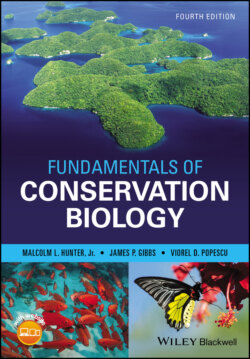Читать книгу Fundamentals of Conservation Biology - Malcolm L. Hunter Jr. - Страница 29
Species, Genes, and Ecosystems
ОглавлениеIt is easiest to comprehend the idea of maintaining biodiversity in terms of species that are threatened with extinction. We know about blue whales, giant pandas, and whooping cranes, and we would experience a sense of loss if they were to disappear, even though most of us have never encountered them except as digital representations in an electronic medium. For most mosses, lichens, fungi, insects, and other obscure species it is much harder to elicit concern. Nevertheless, many people are prepared to extend some of the feelings they have for whales, pandas, and cranes to species they do not know, as an expression of their belief that all species have some intrinsic value.
Genes can also be hard to understand and appreciate. These self‐replicating pieces of DNA that shape the form and function of each individual organism are the organism’s fundamental blueprint, but also important are water, oxygen, and thousands of other molecules. It is not the genes themselves that conservation biologists value; it is the diversity that they impart to organisms that is so essential. If two individual strawberry plants have a different set of genes, one of them might be better adapted to fluctuations in water availability and thus would be more likely to survive a period of climate change. One of them might be less susceptible to damage from ozone and other types of air pollution. The fruit of one might be more resistant to rotting and therefore its progeny might prove useful to strawberry breeders and farmers. Perhaps the fruits simply taste or look different and thereby provide aesthetic diversity. It is these expressions of genetic diversity that we value. The diversity of life is rooted in genetic differences among individuals and the processes of evolution that amplified and shaped these differences among populations to generate distinct species and ultimately the higher taxonomic levels: genera, families, orders, and so on.
Unlike genes, ecosystems are large and conspicuous, and thus anyone with the most rudimentary understanding of ecology appreciates the value of a lake, a forest, a wetland, and so on. Nevertheless, ecosystems can be hard to define in practice. Where do you draw the boundary between a lake and the marsh that surrounds it when many organisms are moving back and forth between the two? This sort of problem can complicate the role of ecosystems in biodiversity conservation. Conservation biologists often advocate protecting examples of all the different types of ecosystems in a region, but how finely should differences be recognized? Is an oak–pine forest ecosystem that is 60% oak and 40% pine appreciably different from one that is 40% oak and 60% pine? If you look hard enough, every ecosystem will be unique. The rationale for protecting ecosystem diversity also differs. Some conservationists advocate protecting ecosystems for their intrinsic value as independent, biological entities of many interacting species, whereas others think of protecting ecosystems simply as an efficient way to protect most of the species that form the ecosystem.
